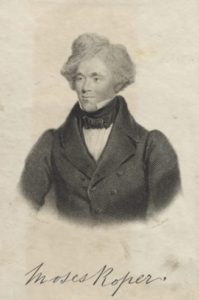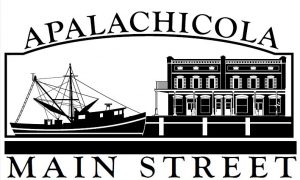The Moses Roper Project

Journey to Freedom: The Odyssey of Abolitionist Moses Roper
Visit the exhibit, now on loan at the Gallery for Innovation and the Arts in the R. A. Gray Building in Tallahassee.
Moses Roper was a freedom fighter, author, lecturer, and survivor of slavery who dedicated his life to the abolitionist cause.
Once enslaved as a steward on an Apalachicola steamboat, Roper later became one of the first Black Americans to publish a slave narrative in Britain.
The exhibition will be the first in the world solely dedicated to exploring Roper’s life and legacy including his bold journey of survival, perseverance and escape in 1834. An 1840 edition of his book and new interactive digital content will be featured.
This project was developed by Apalachicola Main Street, Inc. in collaboration with Hillside Coalition of Laborers for Apalachicola (H'COLA), Dr. Hannah-Rose Murray, Meredith Deveraux, and Lady Dr. Dhyana Ziegler.
Roper made a remarkable escape from slavery in the American South. From humble beginnings he forged a life as one of the most significant abolitionists of the 19th century. His harrowing escape took him from Marianna, Florida to Savannah, Georgia, and from there to New York, New England, and then the UK. A significant aspect of his bold journey of survival, perseverance, and escape from slavery was his experience as an enslaved steamboat steward on the Apalachicola River.
If you’ve never heard the name Moses Roper, you’re not alone. To Americans, Frederick Douglass is perhaps the most famous fugitive from slavery. He travelled to Britain in 1845 where he lectured as an abolitionist and advocate of social justice. However, most are unaware that several years earlier Roper published his memoir, Narrative of the Adventures and Escape of Moses Roper from American Slavery and began lecturing in almost 1,000 locations across the United Kingdom.
Roper was born in Caswell County, North Carolina in 1815, the son of white planter Henry Roper and Nancy, his slave. He was sold away from his family at a young age and changed hands many times through the Carolinas and Georgia. He attempted to escape at least sixteen times, each time being captured and subjected to horrific physical punishments.
As a teenager he was purchased by a Scotsman named Robert Beveridge, a prominent north Florida businessman and founder of the city of Marianna. In the early 1830s steamboats on the Apalachicola-Chattahoochee-Flint River system were a primary mode of transport for cargo and travellers. Beveridge owned three steamboats: the Versailles, the Andrew Jackson, and the VanBuren, some of the first to ply the waters of the tri-river system. Beveridge had a contract to convey the mail between Columbus, Georgia and Apalachicola. Roper was made a steward on board the Versailles, a role that would later be key in his final escape.
The Columbus Weekly Enquirer reported in January of 1833: “The mail packet Versailles, Jacob Rynear master, arrived here on Tuesday last from Apalachicola. Col. Robert Beveridge, of Florida, entered into a contract in October last with the Post Office department, to convey the mail semi-weekly, in steamboats, from Columbus, Georgia, to Apalachicola, Florida, to commence on the first of this instant. The steamer Versailles has been purchased by the contractor and placed in the line and will convey the mail once a week from his place to Apalachicola…This line will serve a regular and safe communication between this point and Florida.”
The article goes on to describe the vessel: “The Versailles is eighteen months old and was employed in carrying the mail on the Ohio river until her arrival on the Chattahoochee. She is a convenient and substantial boat, having cabins spacious and well furnished, and we learn from her commander, Capt. Rynear, that he can run the Versailles without difficulty, whenever he can find twenty-six inches of water.”
The reference to the Versailles’ history on the Ohio River points to a fascinating story. Roper would likely not have known that the same steamboat he worked on had been at the center of a dramatic escape of two fugitive slaves, Thornton and Ruthie Blackburn, less than two years before its arrival in Florida. Their escape using forged documents to travel by steamboat prompted the slaves’ owners to sue the captain and owner of the Versailles. The United States and Canada would also become entangled in a legal battle over the Blackburns that ultimately established Canada as a legally safe haven at the northern end of the Underground Railroad.
But that story was hundreds of miles away from Roper when he first set eyes on the Apalachicola River. In his narrative, he describes his time with Robert Beveridge as a period of better treatment than he had experienced before. However, it would not last long. Roper described what happened next: “In the year 1834, Mr. Beveridge, who was now residing in Apalachicola, a town in West Florida, became a bankrupt, when all his property was sold, and I fell into the hands of a very cruel master…a planter in the same State; of whom, knowing his savage character, I always had a dread.”
This new master’s reputation for his violent treatment of slaves left Roper awash in hopelessness. He wrote, “I cared not whether I lived or died; in fact, whilst I was on my passage from Apalachicola, I procured a quart bottle of whiskey, for the purpose of so intoxicating myself, that I might be able either to plunge myself into the river, or so enrage my master that he should dispatch me forthwith. I was, however, by a kind Providence, prevented from committing this horrid deed by an old slave on board, who, knowing my intention, secretly took the bottle from me.”
They traveled by steamboat to Ocheese Landing in modern day Calhoun County, one of several small towns that had sprung up with the arrival of steamboat traffic on the Apalachicola. From there they were to travel by horseback to his new master’s property on the north Florida border. When they stopped for the night in Marianna, Moses seized the opportunity to run. Thus began his final and successful escape at age 19, an incredible journey that took him hundreds of miles through an often forbidding landscape. His destination was Savannah with the goal of sailing to the North.
Roper describes a harrowing journey that includes hiding in the brush from pursuers, going without food and water for days in the heat of summer, and running from wolves. On crossing one of several rivers he encountered, he was “dreadfully frightened at the crocodiles, and most earnestly prayed that I might be kept from a watery grave and resolved that if again I landed I would spend my life in the service of God.”
Small kindnesses received from people he encountered along the way, such as an enslaved man's last crust of bread and permission to rest for the night on a preacher’s bare floor, helped him find the energy to keep going.
The fact that his father was white and his mother was mixed race (“part Indian, part African”) gave Roper a light complexion. This at times was problematic. His father’s wife was so enraged that her husband had fathered a child with his slave that she attempted to murder Roper as an infant. However, his complexion also enabled him to “pass” for white/Native American on occasion to avoid detection. He was also an extremely intelligent person who was able to devise a way to obtain a written pass that attested to his status as a free man under an alias, remarkably provided for him by a cotton planter and vouched for by white cattle drovers he met in southeastern Georgia.
In August he reached Savannah and headed straight for the docks. In his narrative Roper described the fear he felt entering “one of the greatest slaveholding cities in America, and where they are always looking out for run-away slaves…It required great courage to pass through this place. I went through the main street with apparent confidence, though much alarmed; did not stop at any house in the city, but went down immediately to the docks, and inquired for a berth as a steward on a vessel to New York. I had been in this capacity before on the Apalachicola River.”
Roper’s joy at setting sail for the North faded not long after his arrival in New York. He was dismayed to learn that slave owners advertised bounties for runaway slaves in newspapers far and wide. He saw an advertisement offering a reward for his own capture while living in Vermont. It was a constant fear of recapture that compelled Roper to sail for England in 1835, two years after slavery was abolished there. His contacts with abolitionists in Boston smoothed the way with letters of introduction.
British abolitionists facilitated his education, and Roper published his narrative and lectured in almost 1,000 locations across the U.K. Today, scholars regard his Narrative of the Adventures and Escape of Moses Roper, from American Slavery as a significant early example of the fugitive slave narrative genre. The work was popular with abolitionist readers in both England and America and was published in ten different editions between 1837 and 1856.
Roper’s life and legacy are significant to our diverse history and heritage, but his story has been all but lost to time outside of academic circles. We are working to change that through intense historical research and collaborative projects.
Collaborators include an historian at the University of Edinburgh whose research focuses on amplifying the testimony of fugitive slaves who traveled to Britain; one of Roper’s direct descendants in Australia; the Hillside Coalition Of Laborers for Apalachicola (H’COLA); and others.
Roper’s great-great-great granddaughter of Victoria, Australia is part of this team. “Although his story is heartbreaking, I believe some people are put on this earth just to shine a light on injustice and inequality,” she recently wrote. “Moses exhibited an immense will and courage to change not only the course of his own life but that of his countrymen…He stands tall amongst those whose efforts highlighted the evils of slavery.”
If you’d like to get involved in preserving Roper’s legacy, please get in touch.
Augusta West is the Executive Director of Apalachicola Main Street, Inc. She can be reached at awest@apalachicolamainstreet.org or 844-272-2523. This piece was reprinted from an article she submitted to the Apalachicola Times.
Few people know the name Moses Roper, yet a key chapter in this internationally significant abolitionist’s story is tied to Apalachicola’s historic waterfront. The purpose of this project is to educate the public about Roper’s life, his remarkable escape from slavery, his achievements in the abolitionist movement, and his historical significance.
In addition, we are working to further what is known about this incredible historical figure through research and collaborative efforts to elevate his legacy to its rightful position. We envision several project components that include both a local and much broader reach:
- An educational exhibit, now on display at the Apalachicola Center for History, Culture, and Art;
- The development of teaching materials for schools;
- The development of this website into a comprehensive source for information;
- A state historical marker in Apalachicola; and
- A Moses Roper Trail of historical markers in multiple states that traces the arc of his life and his remarkable escape route from slavery.
This project is innovative because it focuses on one of the lesser-known chapters of Roper’s life--his time in north Florida and his escape across north Florida and South Georgia-- while also building a bridge to what is known about his life in the UK as an abolitionist, author, and lecturer. In some ways, these efforts will mirror and/or connect with projects underway in the United Kingdom to preserve his legacy there.
This project will educate and spark conversation about the roots of racism in this country-- the era of slavery—through the lens of one man’s personal experiences in north Florida. As the nation grapples with issues of racial injustice, Moses Roper’s story is very relevant. The global Black Lives Matter protests and COVID-19 have exposed a need to confront and discuss this history and pay respect to the contributions of black Americans in the U.S., U.K. and beyond.
We are proud to have partnered with the Hillside Coalition Of Laborers for Apalachicola (H'COLA) on this project.
Made possible with grant funding from
And supported by a sponsorship from
We welcome your financial support of our efforts to engage and inspire the public through public education projects that preserve Moses Roper's legacy. This project is part of our commitment to preserve and promote the downtown district's contributions to Florida's diverse historical and cultural heritage.
Contributions at any level will provide sustainability for our efforts to promote downtown Apalachicola's future while preserving its past. There are three ways to give:
- You can place an online donation by clicking here;
- Mail in the printable form with your check; or
- Contact us at (844) 272-2523 to give by phone.
Please note that we are a 501(c)(3) nonprofit organization, and your contribution is eligible for an IRS tax deduction.
A copy of the official registration and financial information may be obtained from The Division of Consumer Services by calling toll-free within the state. Registration does not imply endorsement, approval, or recommendation by the State. 1-800-HELP-FLA (435-7352) or www.FloridaConsumerHelp.com. License # CH44897.
Online Resources:
The University Library of the University of North Carolina at Chapel Hill's Documenting the American South (DocSouth) is a digital publishing initiative that provides Internet access to texts, images, and audio files related to southern history, literature, and culture. You can read the full text Roper's 1848 edition of his Narrative of the Adventures and Escape of Moses Roper, from American Slavery.
Frederick Douglass in Britain is an excellent resource for those interested in transatlantic abolitionism. Click the Moses Roper link on the top menu to see a map of his lecture locations across the British Isles.
Books:
Advocates of Freedom: African American Transatlantic Abolitionism in the British Isles, by Hannah-Rose Murray
North Carolina Slave Narratives: The Lives of Moses Roper, Lunsford Lane, Moses Grandy, and Thomas H. Jones, edited by William Andrews.
The North Carolina Roots of African American Literature: An Anthology, edited by William Andrews.



